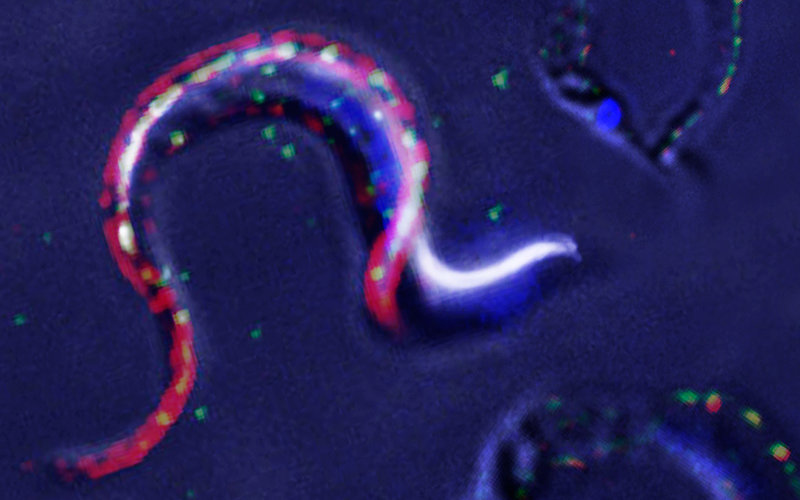
Infections from parasites affect millions of people every year in the United States and in developing countries. Limited drug treatments and lack of vaccines motivated Cal State Fullerton scientist Veronica Jimenez to study how parasites cause infectious diseases in humans.
Jimenez and her students study the parasite Trypanosoma cruzi, transmitted by triatomine bugs, commonly known as “kissing bugs,” which cause the life-threatening Chagas disease.
“My research focuses on understanding how parasites responsible for human diseases deal with changes in their environment so they can survive and continue infecting new hosts,” said Jimenez, associate professor of biological science.
In particular, Jimenez studies how trypanosome parasites can sense the characteristics of their surroundings and infect by a process called mechanosensation.
“This is important for the parasites to detect whether they are in the blood, the inside of a cell they are invading or outside in the environment,” she said. “This is the same process that allows us, as well as parasites, to ‘feel’ our surroundings. In humans, mechanosensation makes possible the sense of touch, hearing and balance.
“Infective parasites use the same senses to find a suitable host to invade. We want to understand how they do it, in hopes that we can leverage that information to develop new therapies.”
Studying Parasitic Diseases in Humans
Worldwide, it is estimated that about 8 million people are affected with Chagas disease, and in the U.S., there are more than 300,000 cases. The disease can cause heart diseases and increase the risk of stroke. Chagas disease is one of several parasitic diseases targeted by the Centers for Disease Control and Prevention for public health action.
Jimenez has received more than $1 million in funding for her parasite research, including from the National Institutes of Health and American Heart Association. For nearly two decades, she has investigated Chagas disease, as well as other parasitic diseases, including sleeping sickness and toxoplasmosis, which is caused by the parasite Toxoplasma gondii.
Toxoplasmosis usually causes no problems in healthy individuals, but it can cause fetal malformation if the mother gets infected while pregnant and it can be fatal in immunocompromised people, she noted.
In her latest study, Jimenez and her students reveal insights to possible new treatments for Chagas disease. Published earlier this year in Frontiers in Cellular and Infection Microbiology, the research focuses on the biology of the parasite that the kissing bugs carry. The paper describes how Trypanosoma cruzi maintains its internal electrolytes.
Electrolytes are important for water balance in all organisms — and the parasites are no exception, Jimenez pointed out.
“This parasite uses proteins to regulate how much salt and water is coming in and out. This allows them to stay alive and continue their infective cycle,” she said.
The researchers found and described one of these proteins, called TcCAKC. When it is taken away, the parasites have trouble surviving and infecting new cells, she explained.
“This is very exciting since it can provide a new target for developing drugs to treat this disease that otherwise has no effective treatment.”
Co-authors of the journal paper are her former students Noopur Dave ’13, ’17 (B.S. biological science-cell and developmental biology, M.S. biology), a doctoral student at Indiana University School of Medicine; Christopher Skorka ’18 (M.S. biology), who is planning to go to medical school; Michael Boktor ’17 (B.S. biological science-cell and developmental biology), who is pursuing dentistry school; and Patricia Barrera, a former postdoctoral researcher in Jimenez’s lab, now at the medical school at the National University of Cuyo in Argentina.
Jimenez and her students are continuing their research efforts to learn more about the biology of parasites and how it is different from the biology of humans.
“This can lead to discovering pathways that are essential for the parasite, but not present in humans, then we can design drugs targeting those pathways. At the end, the idea is to kill the parasite without causing damage or side effects in the person infected with them.”
Contact: Debra Cano Ramos, dcanoramos@fullerton.edu